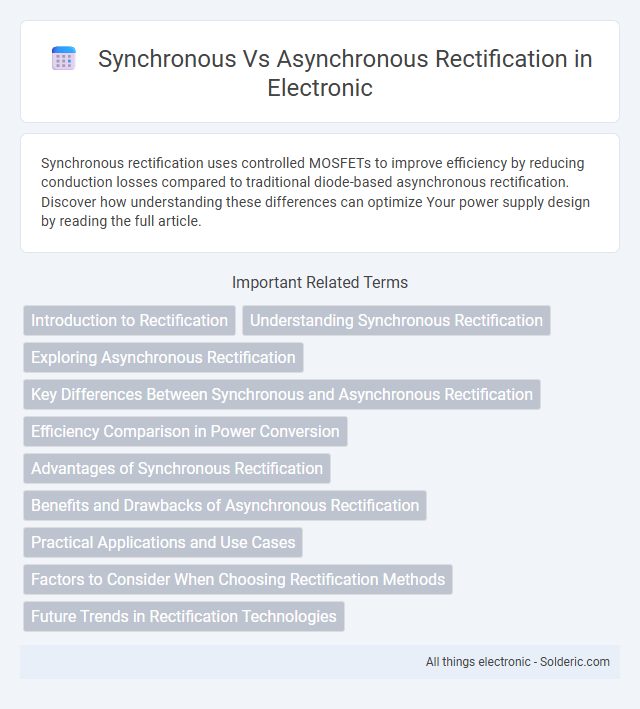Synchronous rectification uses controlled MOSFETs to improve efficiency by reducing conduction losses compared to traditional diode-based asynchronous rectification. Discover how understanding these differences can optimize Your power supply design by reading the full article.
Comparison Table
| Feature | Synchronous Rectification | Asynchronous Rectification |
|---|---|---|
| Switch Type | Active MOSFET switches | Passive diodes |
| Efficiency | Higher efficiency due to lower conduction losses | Lower efficiency as diodes have higher voltage drops |
| Conduction Loss | Low conduction loss, typically < 0.1V drop | Higher conduction loss, approx 0.7V drop |
| Complexity | Requires control circuitry for MOSFET timing | Simple, no control needed |
| Cost | Higher cost due to additional components and control | Lower cost, fewer active components |
| Thermal Performance | Improved thermal efficiency with less heat generation | More heat generated due to diode losses |
| Application | High efficiency power supplies, low voltage DC-DC converters | Basic rectification, less efficiency-critical devices |
Introduction to Rectification
Rectification converts alternating current (AC) to direct current (DC) using diodes or transistors, essential for power supply regulation. Synchronous rectification utilizes low-resistance MOSFETs instead of diodes, reducing conduction losses and improving efficiency. Asynchronous rectification relies on standard diodes, which introduce higher voltage drops and power dissipation during conversion.
Understanding Synchronous Rectification
Synchronous rectification improves power conversion efficiency by replacing traditional diodes with actively controlled MOSFETs that have lower voltage drops, reducing conduction losses in DC-DC converters. Understanding synchronous rectification is crucial for optimizing power supplies in applications such as computer motherboards, battery management systems, and high-current regulators. By using precise timing to switch MOSFETs on and off, your electronic designs achieve higher efficiency and lower heat dissipation compared to asynchronous rectification methods.
Exploring Asynchronous Rectification
Asynchronous rectification utilizes standard diodes to convert alternating current (AC) to direct current (DC), relying on the inherent forward voltage drop of the diodes for conduction, which results in higher power dissipation compared to synchronous rectifiers. This method is simpler and more cost-effective for low-power applications but causes increased heat generation and lower efficiency in high-current scenarios. Despite these drawbacks, asynchronous rectification remains widely used in basic power supplies and low-frequency circuits where efficiency demands are less stringent.
Key Differences Between Synchronous and Asynchronous Rectification
Synchronous rectification uses MOSFETs controlled by the circuit to replace diodes, reducing power loss and improving efficiency compared to asynchronous rectification, which relies on traditional diodes. Key differences include the lower voltage drop in synchronous rectifiers due to the active switching devices, and the need for more complex control circuitry to manage timing and prevent shoot-through currents. Your power supply design benefits from synchronous rectification when high efficiency and reduced heat generation are priorities, especially in low-voltage, high-current applications.
Efficiency Comparison in Power Conversion
Synchronous rectification dramatically improves efficiency in power conversion by replacing diodes with low-resistance MOSFETs, reducing conduction losses and heat generation. Asynchronous rectifiers typically suffer from higher voltage drops across diodes, leading to lower energy efficiency and increased thermal stress. Understanding the efficiency benefits of synchronous rectification helps you optimize power supply designs for enhanced performance and reduced energy consumption.
Advantages of Synchronous Rectification
Synchronous rectification offers significant efficiency improvements by replacing traditional diodes with low-resistance MOSFETs, reducing conduction losses and heat generation in power converters. This method enhances power density and reliability in applications such as DC-DC converters and power supplies, enabling higher current capabilities and lower voltage drops. Optimized switching control in synchronous rectification also leads to improved overall energy savings and system performance.
Benefits and Drawbacks of Asynchronous Rectification
Asynchronous rectification offers simplicity and lower initial costs due to its use of diodes instead of active components, which reduces design complexity and enhances reliability for basic power supply applications. However, it suffers from higher conduction losses and lower efficiency compared to synchronous rectification, especially at low voltage and high current conditions, leading to increased heat dissipation and energy waste. Understanding these trade-offs helps you decide when asynchronous rectification is suitable for your power conversion needs.
Practical Applications and Use Cases
Synchronous rectification is widely used in high-efficiency power supplies for datacenters and consumer electronics, where minimizing conduction losses is critical. Asynchronous rectification remains favored in simpler, cost-sensitive applications like small adapters and traditional power conversion circuits. The choice between synchronous and asynchronous rectification hinges on efficiency requirements, cost constraints, and thermal management considerations in real-world applications.
Factors to Consider When Choosing Rectification Methods
When choosing between synchronous and asynchronous rectification, factors such as efficiency, cost, and complexity are critical. Synchronous rectification offers higher efficiency by using MOSFETs instead of diodes, reducing conduction losses, but it requires a more complex control circuit. Your decision should consider the application's power level, thermal management, and design constraints to optimize performance and reliability.
Future Trends in Rectification Technologies
Future trends in rectification technologies emphasize the integration of wide-bandgap semiconductors like GaN and SiC to enhance efficiency and reduce switching losses in both synchronous and asynchronous rectifiers. Advanced control algorithms combined with artificial intelligence are being developed to optimize rectifier performance dynamically under varying load conditions. The shift toward miniaturization and higher frequency operation is driving innovation in rectification circuits for power conversion in electric vehicles and renewable energy systems.
Synchronous vs Asynchronous Rectification Infographic

 solderic.com
solderic.com